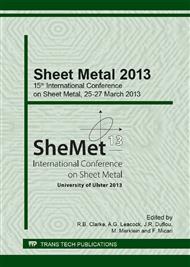p.3
p.13
p.21
p.31
p.39
p.45
p.53
p.61
p.68
Comprehensive Material Characterization for an Intermediate Heat Treatment
Abstract:
Encouraged by increasing climate regulations there is a trend to lightweight constructions in the transportation sector, particularly in the automotive industry. An auspicious possibility to reduce the weight of the vehicle is the substitution of conventional steel by aluminum alloys. However, aluminum has a low formability and therefore new technologies have to be found in order to enhance the materials spectrum of application. A new strategy to extend the process limit is the short-term aluminum intermediate heat treatment between two forming operations. Key idea is the partial adaption of the mechanical properties with a short term heat treatment. By the interaction of soft and hard areas the material flow during the forming operation can be improved and the formability can be enhanced. Prerequisite for a successful application of the technology and the numerical simulation is a comprehensive knowledge about the interaction of pre-straining and a subsequent short term heat treatment. Within this paper the mechanical properties in dependency of the two parameters will be presented and a process window for the heat treatment after first forming operations will be derived. Moreover, the influence of batch fluctuations and the impact of ageing will be demonstrated.
Info:
Periodical:
Pages:
39-44
Citation:
Online since:
April 2013
Authors:
Price:
Сopyright:
© 2013 Trans Tech Publications Ltd. All Rights Reserved
Share:
Citation:


